Common Settings in Art Deco Engagement Rings
| Invest in Hidden Masterpiece: Rare Antique Oil Paintings For Sale. Limited Originals Available 💰😊 Are you looking for authentic hidden masterpiece? Explore old master antique oil paintings from the Renaissance and Baroque eras. From 16th-century portraits to 18th-century landscapes. Authenticity guaranteed, Old Master antique oil paintings for sale. Shop Now! 🎨 Renaissance And Baroque Art Landscape Antique Paintings Old Master Portrait Paintings |
Art Deco engagement rings, with their bold geometry, refined craftsmanship, and luxurious materials, remain a popular choice for those who appreciate vintage aesthetics or historically significant design. Originating in the 1920s and 1930s, the Art Deco movement emphasized modernity, symmetry, and a fascination with industrial innovation. In jewelry, this translated into crisp lines, stylized motifs, and an unmistakable architectural quality. This article provides a comprehensive, search-engine-optimized examination of common settings in Art Deco engagement rings, what defines an engagement ring as Art Deco, whether these pieces retain value, and how a modern $20,000 budget fits into the broader engagement ring landscape.
Art Deco settings were informed by both design philosophy and technological advancements of the early twentieth century. Jewelry artisans had newly improved tools for stone cutting, metal fabrication, and mass production, enabling highly detailed settings with geometric precision.
1. Geometric Halo Settings
Halo settings were not invented during the Art Deco period, but they were dramatically reinterpreted. Instead of the soft, rounded halos common in contemporary rings, Art Deco halos were angular, often square, hexagonal, or octagonal. These geometric halos were designed to mirror the clean lines of the center stone, particularly the emerging popularity of the Asscher cut.
2. Asscher and Emerald Cut Centers
While technically a stone shape, the setting surrounding an Asscher or emerald-cut diamond influenced the entire presentation of the ring. Art Deco designs favored step-cut stones due to their hall-of-mirrors optical effect, which aligned perfectly with the movement’s emphasis on symmetry and clarity. These stones were often set in four- or double-prong arrangements, with metalwork that framed their rectangular or octagonal silhouettes.
3. Filigree and Milgrain Settings
Filigree, the delicate, lace-like metalwork, was widely used due to advancements in platinum fabrication. Platinum’s strength allowed jewelers to craft ultra-fine, structural filigree elements that would have been too fragile in gold. Milgrain, the beaded-edge detailing used to highlight borders, created visual texture while accentuating geometric lines.
4. Calibre-Cut Gemstone Accents
One hallmark of Art Deco settings is the use of calibre-cut stones, gemstones cut specifically to fit within a precise geometric border. Sapphires, rubies, and onyx were commonly used as contrasting accents, often forming linear or stepped patterns around the center stone. These stones were channel-set, producing a sleek surface that reinforced the era’s architectural aesthetic.
5. Architectural and Structural Mountings
Influenced by skyscrapers, bridges, and early industrial design, many rings displayed tiered or stepped motifs. The settings often incorporated architectural elements such as stacked shoulders, stepped galleries, and supportive, structured undercarriages that emphasized verticality.
6. Three-Stone and Multi-Stone Arrangements
Triadic symmetry was a recurring theme in Art Deco jewelry. Three-stone engagement rings from this period typically used side stones that complemented the center stone’s shape, such as tapered baguettes flanking a rectangular diamond. Multi-stone arrangements with balanced proportions contributed to visual cohesion and harmony.
What Makes an Engagement Ring Art Deco?
Not every ring from the 1920s or 1930s qualifies as Art Deco, nor does every geometric or vintage-inspired design. An engagement ring is classified as Art Deco based on adherence to the era’s stylistic and technical hallmarks.
1. Strong Geometric Forms
Art Deco jewelry embraced straight lines, bold angles, and crisp edges. Rings featured squares, rectangles, hexagons, octagons, and stepped patterns. Even round stones were often set within geometric frames to maintain period consistency.
2. Symmetry and Balance
Art Deco design prioritizes symmetry and order. Engagement rings of the era were engineered with precisely balanced proportions, ensuring that elements on one side mirrored those on the other.
3. Platinum Dominance
While white gold became popular in the late 1920s, platinum remained the metal of choice for high-end Art Deco engagement rings. Its durability allowed jewelers to create the intricate filigree and structural details associated with the style.
4. Use of Step-Cut Diamonds
Art Deco rings often feature Asscher, emerald, or baguette cuts. These cuts emphasize clarity, reflection, and linear geometry rather than the brilliant scintillation of modern round brilliant diamonds.
5. Contrasting Gemstones
Sapphires, rubies, emeralds, and onyx were frequently integrated into Deco designs for contrast and graphical impact. These stones enhanced the monochromatic sheen of platinum and diamond.
6. Decorative Metalwork
Milgrain, filigree, openwork, and engraved patterns are common signatures of authentic Deco craftsmanship. These details create depth and patterning that distinguish period rings from modern minimalist designs.
7. Historical Authenticity
Finally, provenance plays a role. A ring created during the actual 1920–1939 period with period-correct materials and construction techniques is considered an authentic Art Deco ring. Modern reproductions can emulate the style but not the historical origin.
Are Art Deco Rings Worth Anything?
Art Deco engagement rings have significant value, both financially and historically. Their worth is influenced by multiple factors, including rarity, craftsmanship, condition, and materials.
1. Antique Market Demand
Vintage and antique jewelry, especially from well-defined design eras, has experienced sustained demand. Art Deco pieces are among the most collectible due to their distinctive style and enduring elegance.
2. Rarity and Authenticity
Original Art Deco engagement rings are finite in supply. As these pieces age, intact examples with original stones and settings become increasingly rare. Authenticity, confirmed by examination of construction techniques and wear patterns, substantially impacts value.
3. Craftsmanship Quality
Art Deco rings were often handcrafted with meticulous detail. The level of filigree, cut precision, and symmetry is difficult to replicate at scale today. buyers often pay a premium for workmanship that reflects early twentieth-century artisan labor.
4. Material Composition
High-quality platinum, antique diamonds (often with old European or early step cuts), and calibre-cut gemstones enhance the intrinsic value of an Art Deco ring. Platinum’s durability helps preserve structural integrity, reducing long-term degradation.
5. Designer and Maison Provenance
Rings from renowned houses such as Cartier, Tiffany & Co., or Van Cleef & Arpels command exceptional premiums. Documentation or hallmarks significantly increase resale and appraisal value.
6. Condition and Restorations
Art Deco rings that remain in largely original condition, without major stone replacements or structural alterations, are more valuable. Sensitive restoration may be acceptable, but heavy modern modifications typically reduce authenticity and resale value.
7. Investment Potential
While engagement rings should not be treated primarily as financial investments, high-quality Art Deco pieces often appreciate modestly over time. Their stable demand and limited supply contribute to slow but consistent value retention.
In general, Art Deco rings absolutely hold value, and high-end examples can be worth tens of thousands of dollars depending on materials and provenance.
Is $20,000 a Lot for an Engagement Ring?
Whether $20,000 is “a lot” depends on personal financial context, cultural expectations, and the general benchmarks within the jewelry industry. From a market perspective, $20,000 is considered a premium budget.
1. Industry Averages
Most estimates show that the average engagement ring in the United States costs between $5,000 and $7,500. This number fluctuates by region, retailer, and materials, but a $20,000 ring sits well above typical spending patterns.
2. Purchasing Power at the $20,000 Level
A $20,000 budget allows for:
- 1.5 to 3-carat diamonds depending on cut, clarity, color, and shape.
- High-quality platinum settings.
- Custom or designer mountings.
- Authentic Art Deco engagement rings with strong provenance.
At this price point, buyers can access heirloom-tier pieces, including genuine antique Art Deco rings.
3. Value Considerations
A $20,000 engagement ring is a luxury purchase. For financially stable buyers seeking craftsmanship, rarity, or historical significance, such as a premium Art Deco ring, the budget aligns with market norms for high-end pieces.
However, the value should be assessed in relation to:
- personal income,
- financial obligations,
- lifestyle goals, and
- long-term financial planning.
4. Emotional Versus Financial Value
Engagement rings hold symbolic value beyond their financial cost. Some couples prioritize size or rarity; others favor modest rings and invest savings elsewhere. Whether $20,000 is appropriate ultimately hinges on the couple’s shared preferences and priorities.
5. Market Positioning
In contemporary jewelry markets, a $20,000 ring occupies the luxury tier but not the ultra-luxury tier. Many designer brands sell engagement rings that exceed $30,000–$100,000 depending on stone quality and design complexity. Therefore, while $20,000 is certainly a significant amount, it is far from the upper limit of the engagement ring market.
Art Deco engagement rings offer a compelling combination of historical artistry, structural precision, and bold design language. Their common settings, geometric halos, step-cut stones, filigree details, and architectural motifs, reflect the modernist vision of the early twentieth century. A ring is considered Art Deco when it adheres to the geometric, symmetrical, and artisanal characteristics of the period, particularly when crafted from platinum and featuring step-cut diamonds or calibre-cut gemstones.
Art Deco rings are indeed valuable, both intrinsically and as collectible antiques. Their rarity, craftsmanship, and historical provenance ensure they retain strong market demand. For buyers considering a $20,000 budget, this amount qualifies as a premium but not extreme investment





